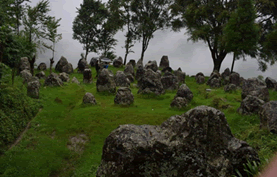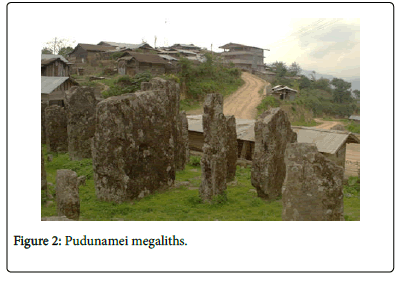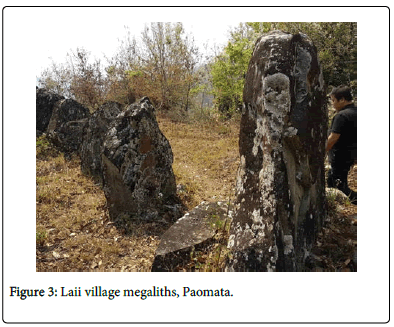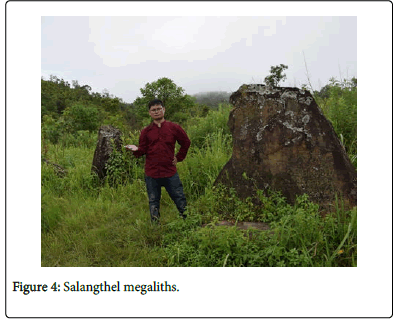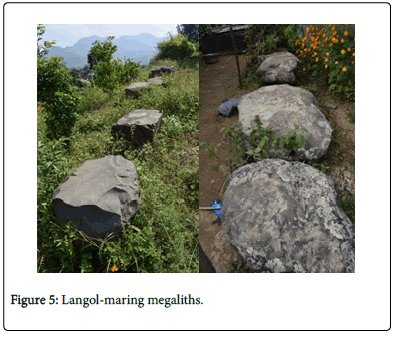Biodeterioration Study of the Prehistoric Megalithic Rock Structures of Manipur: A Case Study
Received: 22-May-2020 / Accepted Date: 09-Jun-2020 / Published Date: 16-Jun-2020 DOI: 10.4172/2155-6199.1000470
Abstract
Megalithism is a universal human phenomenon which has been present since prehistoric times. In the field of biodeterioration, natural and artificial stone materials are studied the most because of their wide distribution and as they are the main elements of the archaeological, monumental heritage and due to their outdoor locations, they are subjected to the adverse environmental factors like sunlight, frost, wind and rain etc. Moreover, biological activity also plays a role in its interaction with physico-chemical integrity of the rock materials. Colonization of microorganisms on historic building materials and deterioration is usually linked to environmental conditions. Lichens, algae and mosses growing on prehistoric rock art pose a major worldwide threat for its preservation and conservation. Lichen colonization affects the rock art by both mechanical and chemical actions, through rhizines penetration, expansion and contraction of thallus, production of oxalic acids and other lichenic acids, and chelation of metal ions etc. This study is an effort to identify the lichen colonization as the deteriorating factors of the prehistoric megaliths of Manipur. Lichen samples were collected from five different megalithic sites of Manipur and to study the changes taking place in the lichen-rock interface. The challenges and possible prospects of this research will help to compile the information available on the lichen taxa growing on different megalithic sites of Manipur, for identification of the lichen species present on each megalithic site and to call upon various researchers, scientists and conservators to study the present condition of the megaliths, and come up with possible preservation and conservation schemes.
Keywords: Prehistoric megaliths; Biodeterioration; Lichens; Identification
Introduction
The term ‘megalith’, which has been originated from the ancient Greek megas meaning large and lithos meaning stone, stands for large stones either standing alone or assembled to form a structure or monument. These rock-structures have been found in different parts of the world and may have multiple meanings–funerary, commemorative, religious and ceremonial etc. They generally belonged to prehistoric times, while some continue to have modern-day relevance to living communities. The meanings in them are varied, and studies have given diverse insight into socio-political, economic and ideological life of prehistoric societies. Some authors [1-3] see them as representation of an elite class of individuals and groups. Few studies focused on the symbolism inherent [4,5] while a few others contended they were used for astronomical observations [6,7].
The megalithic monuments are among the most widespread remains of stone age both in time and space. They are found in many parts of the world- in western Europe, Mediterranean region, Western Asia, South Asia and Melanesia. The origin of these monuments is placed in the Mediterranean. In other words, the megalithic culture has no regional bounds as its cultural marks are found all over the World.
Historical Background
The megalithic studies in the northeast area of India began with the arrival of the British, after 1826, when the administrative officers had to record the monographs of the local groups. The discovery of megalithic sites in Manipur by T.C. Hudson in 1900 and J.H. Hutton in 1928-29 constitutes a new chapter in the Indian Archaeology. Megalithic monuments of Willong and Maram area were first noticed in 1900 and reported by T.C. Hodson in his book, The Naga Tribes of Manipur, under the heading ‘Stones and stone monuments’ published in 1911(reprint1989). Besides he also mentioned various megaliths that were constructed and planted by different tribes of the state [8]. In 1929, J.H. Hutton reported about the confuse groups of stones at all angles found in Willong which was also mentioned as Gwillong [9]. The Megalithic monuments of Maos areas had been reported by Singh. Although none of the megalithic structure of North East India has yet been dated, it is agreed by all writers that the customs of erection of megaliths prevailed in northeast India from the prehistoric period [10-13].
Megalithic monuments of Salangthel site, Curachandpur district, Manipur were first noticed and reported by Mutua Museum in 1983. Then Kunjeshwori also reported briefly about the megalithic remains of Manipur, (Salangthel, Uilong and Keithelmanbi area only) in her Ph.D. thesis in 1988 [14].
Binodini [16] (1993) in her research paper Studies on the megalithic remains of Manipur has given a list of twenty-four megalithic sites based on the communities of Manipur. Following the list, five megalithic sites have been selected depending on the availability of lichen colonization and different location.
Cultural significance
The custom of erecting megaliths has been discontinued in many regions of the world with the coming of Christianity and modernization, the stone erection as a memorial monument are still prevalent in the state of Manipur, especially in the Senapati District Within the district, there are several tribes belonging to the larger Naga fold that received particular focus of megalithic tradition, and these include-Mao, Maram, Poumai, Liangmai, Zemei and Koireng etc.
It is considered that the raising of megaliths by two different Naga tribes is done with different purposes-for the Poumais, it is to enhance one’s social position by way of giving a feast, and for the Koirengs to commemorate the accession of throne of a new village head. The raising of composite megalithic monument i.e. menhir compositely with dolmen (called seifun) is done to commemorate the accession of a new village chief called khuoreng by performing a feast called khulakphunnikho. The Poumai tribe on the other hand performed kosodotah or zhosotoh to enhanced status of the performer in the society by erecting monolith in his name by way of performing a series of expensive feasts.
Selected megalithic sites
- Willongkhullen, Senapati district (Maram tribes) (Figure 1)
- Pudunamei, Senapati district (Mao tribes) (Figure 2)
- Laii village-Paomata, Senapati district (Poumai tribes) (Figure 3)
- Salangthel, Churachandpur district (Rongmei/Kabui tribes) (Figure 4)
- Langol-maring, Machi, Chandel district Maring tribes) (Figure 5)
Research Methodology
Sample collection
The lichen samples were collected with the help of scalpel, brushes for the fructose and fructicose types (non-destructive); chisel and hammer for the crustose types and rock samples (destructive). The specimens were placed on a hard card sheet and packed in a lichen herbarium packet with the details of the locality.
The micro or macrolichens are visible to the naked eye in the field. However, a hand lens, preferably of 10X, is necessary to examine the structure of the thallus and confirm while collection the lichens. A sharp, flat edge chisel and a hammer are the tools required for collecting lichens. The pointed, long chisel and heavy hammer are recommended for collecting lichens growing on rocks. Polythene packets, rubber bands, labelling stickers, global positioning system (GPS), a field notebook, pen, pencil, plant press, old newspaper or blotters, nylon ropes, collection bags, herbarium packets are the necessary items needed during lichen collection trip. The lichen samples are normally advised to be collected along with their substratum irrespectively of their growth form. While the lichens that were loosely attached to substratum were collected by scrapping out using a chisel; for the saxicolous lichens, the samples were collected with the substratum. Collection of lichen sample in ‘sufficient’ amount (at least 2 thallus) is necessary, as the material will be used for detailed microscopic as well as chemical studies [17,18].
Identification
The collected samples were identified after studying their morphology and anatomy in CSIR-National Botanical Research Institute, Lucknow. The stereo-microscope was used for observing isidia/soredia, rhizines, colour of thallus, cilia and apothecia etc. A free hand thin section of the apothecia and medulla were used for their anatomical study. The section was mounted in distilled water for studying the colour and the crystals of epihymenium, hymenium, subhymenium, hypothecium and to measure the ascus and ascospores size and colour of medulla. Following the methods colour spot test, TLC and micro-crystallography, the following lichen species were identified.
| Megalithic sites | Lichen species |
|---|---|
|
Willongkhullen Senapati district |
Parmotremareticulatum (Taylor) M Choisy, Porpidaalbocoe rulescens (Wulfen) Hertel&Knoph, Lecideaplana (J.Lahm) Nyl.,Lecidellastigmatea (Ach.) Hertel&Leuckert, Parmeliasulcata Taylor, Lecanorasulphurescens (Fe?e) LecanoraformosulaLumbsch, Diploschistes actinostomus (Ach.) Zalhbr Dirinaria applanata (Fe?e) |
|
Pudunamei Mao, senapati district |
Parmotre areticulatum (Taylor) M Choisy, Usneatigmatoides G. Awasthi, Lecanora fimbriatulaStirt. Lepraria sp. |
|
Laii village, Paomata Senapati district |
Heterodermia japonica (M. Sato) Diploschistes actinostomus (Ach.) Zalhbr, Lecanorahell michiana Poelt., Lecanorafimbriatula Stirt.Parmotremaindicum Hale, Heterodermiadiademata (Taylor) D.D.Awasthi |
|
Salangthel Churachandpur district |
Pertusariaindica Preeti Srivast. & D.D.Awasthi, Lecanora fimbriatula Stirt. Cryptothecia subnidulans Stirt. Buellia sp. |
|
Langol-maring, Machi village Chandel district |
Dirinariaconsimilis (Stirt.), Caloplacabassiae (Ach.) Zalhbr., Pertusaria sp. Bulbothrixisidiza (Nyl.) Hale, Dirinaria sp. |
Table 1: Identified lichen species.
Results and Discussion
Challenges and prospects
Conservation is a multidisciplinary subject and sometimes we faced difference in perspectives from different area of studies as well. An interesting discussion that came into account was, as a student of an art conservation, it has been advised to us that we should always perform a minimal intervention, to collect samples with minimum effect on the object or substrate i.e., In this case, from the conservation point of view, we should collect a minimal sample from the megaliths and to study its biodeteriorating factors for the study of- preservation of the prehistoric megaliths. While from the lichenogical field of studies, we are advised to collect as many samples as possible, because sometimes it is hard to identify the lichen species if we didn’t collect its thallus with the fruiting bodies intact because sometimes the collected lichen samples can be sterile. Moreover, there is also a case of endemic species, i.e. Lichen species that are found only on that specific environment condition. Thus, from the lichenological point of view, we should collect as many samples possible and to study their present microclimate for the- preservation of lichens.
Therefore, if possible, it should be noted that we should consider the possible factors that the outcome of a research will affect in other field of studies. In this case, as the research is on the lichens as a biodeteriogen of the prehistoric megaliths, the emphasis will be on the preservation of the selected megaliths. The possible preservation treatment that will depend on the availability of endemic species of lichens can be discussed for the future researches.
There have been many researches regarding the deteriorating effects of the lichens on the rock monuments, but not much of the northeast region of India. This research may be the first to study the deteriorating factors of the lichens on the megalithic sites of Manipur. Some of the challenges faced during this study can be summed up as-
Challenges:
• Megalithic sites were every remotely situated from the city.
• Unprotected and ignored, no maintenance due to the unawareness of its importance.
• No proper map of the sites and had to search for hours by asking the localite.
• High cost of testing charges in research laboratories
• Unexpected failures of the research equipment etc.
Prospects: The possible prospects of this research that can mentioned are-
• A proper research studies for the lichen species and minerals database found on each site
• It acts as a cultural identity of the respective communities and should be preserved and protected accordingly
• Could be a Cultural destination for the researchers and tourists
• Could create an awareness of their respective tribal histories and myths related with their megalithic culture practices.
Conclusion
This research study is an effort to create awareness of the importance of these prehistoric megalithic rock architectures to the general population of Manipur and also to the respective local communities of the megalithic sites, which have been existing being ignored and unprotected. It is only a little step to compile the info available on the lichen taxa growing on the different megalithic sites of Manipur, to call upon various researchers, scientists and conservators to study the present condition of the megaliths. To study the biodeteriorating factors of the lichens, the changes taking place in the lichen-rock interface, the extent of biodeterioration caused by their colonization on the megalithic sites and to and to come up with possible preservation and conservation schemes.
References
- Sherratt A (1990) The genesis of megaliths: Monumentality, ethnicity and social complexity in Neolithic North-West Europe. WorlArchaeol 22: 147-167.
- Nelson SM (1999) Megalithic monuments and the introduction of rice into Korea. In: Gosden C,Hather J (eds) The prehistory of food: Appetites for change. New York; Routledge. Pp: 147-165
- Hodder I (1990) The domestication of Europe: Structure and contingency in neolithic societies. Oxford, Basil Blackwood, USA.
- Bradley R. (1998) The significance of monuments: On the shaping of human experience in neolithic and bronze age Europe. Routledge, London.
- MacKie E (1997) Maeshowe and the winter solstice: Ceremonial aspects of the orkneygrooved ware culture. Antiquity 71:338-359.
- Singh OK (1978) A live megalithic culture in Manipur. Recent advances in Indo-Pacific Prehistory. Proceedings of the International Symposium. Pune.
- Singh OK (1980) Archaeological researches in Manipur. Eastern Himalayas, Cosmo Publication. Pp.147-162.
- Clarke CB (1874) Thestone monuments of Khasi Hills. J Roy Anthropological Inst 4: 481-493.
- Binodini P (2011) The megalithic culture of Manipur. Agam Kala Prakashan, New Delhi.
- Maringmei Philip (2017) A study on the megalithic monuments of the Senapati district of Manipur. Ph.D. Thesis. Department of Anthropology. Manipur University.
- Binodini P (1993) Studies on the Megalithic remains of Manipur. Unpublished Ph.D. Thesis. Department of Anthropology. Guwahati University.
- Nayaka S (2014) Methods and techniques in collection, preservation and identification of lichens. Plant taxonomy and biosystematics-classical and modern methods. New India Publishing Agency, New Delhi. pp.102-128.
- Kamaljit K (2019) Saxicolous Lichens and biodeterioration of the megaliths of Manipur: An overview. Kalakalpa. IGNCA J of Arts. 4: 179-203.
Citation: Kamaljit K, Pandey S (2020) Biodeterioration Study of the Prehistoric Megalithic Rock Structures of Manipur: A Case Study. J Bioremediat Biodegrad 11: 470. DOI: 10.4172/2155-6199.1000470
Copyright: © 2020 Kamaljit K, et al. This is an open-access article distributed under the terms of the Creative Commons Attribution License, which permits unrestricted use, distribution, and reproduction in any medium, provided the original author and source are credited.
Share This Article
Recommended Journals
Open Access Journals
Article Tools
Article Usage
- Total views: 3280
- [From(publication date): 0-2020 - Apr 27, 2025]
- Breakdown by view type
- HTML page views: 2415
- PDF downloads: 865

